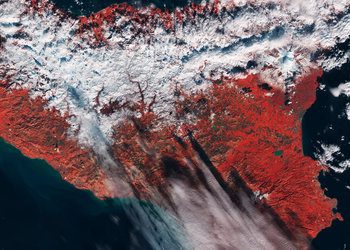Accept all cookies Accept only essential cookies See our Cookie Notice

About ESA
The European Space Agency (ESA) is Europe’s gateway to space. Its mission is to shape the development of Europe’s space capability and ensure that investment in space continues to deliver benefits to the citizens of Europe and the world.
Highlights
ESA - United space in Europe
This is ESA ESA facts Member States & Cooperating States Funding Director General Top management For Member State Delegations European vision European Space Policy ESA & EU Space Councils Responsibility & Sustainability Annual Report Calendar of meetings Corporate newsEstablishments & sites
ESA Headquarters ESA ESTEC ESA ESOC ESA ESRIN ESA EAC ESA ESAC Europe's Spaceport ESA ESEC ESA ECSAT Brussels Office Washington OfficeWorking with ESA
Business with ESA ESA Commercialisation Gateway Law at ESA Careers Cyber resilience at ESA IT at ESA Newsroom Partnerships Merchandising Licence Education Open Space Innovation Platform Integrity and Reporting Administrative Tribunal Health and SafetyMore about ESA
History ESA Historical Archives Exhibitions Publications Art & Culture ESA Merchandise Kids Diversity ESA Brand Centre ESA ChampionsLatest
Space in Member States
Find out more about space activities in our 23 Member States, and understand how ESA works together with their national agencies, institutions and organisations.
Science & Exploration
Exploring our Solar System and unlocking the secrets of the Universe
Go to topicAstronauts
Missions
Juice Euclid Webb Solar Orbiter BepiColombo Gaia ExoMars Cheops Exoplanet missions More missionsActivities
International Space Station Orion service module Gateway Concordia Caves & Pangaea BenefitsLatest
Space Safety
Protecting life and infrastructure on Earth and in orbit
Go to topicAsteroids
Asteroids and Planetary Defence Asteroid danger explained Flyeye telescope: asteroid detection Hera mission: asteroid deflection Near-Earth Object Coordination CentreSpace junk
About space debris Space debris by the numbers Space Environment Report In space refuelling, refurbishing and removingSafety from space
Clean Space ecodesign Zero Debris Technologies Space for Earth Supporting Sustainable DevelopmentLatest
Applications
Using space to benefit citizens and meet future challenges on Earth
Go to topicObserving the Earth
Observing the Earth Future EO Copernicus Meteorology Space for our climate Satellite missionsCommercialisation
ESA Commercialisation Gateway Open Space Innovation Platform Business Incubation ESA Space SolutionsLatest
Enabling & Support
Making space accessible and developing the technologies for the future
Go to topicBuilding missions
Space Engineering and Technology Test centre Laboratories Concurrent Design Facility Preparing for the future Shaping the Future Discovery and Preparation Advanced Concepts TeamSpace transportation
Space Transportation Ariane Vega Space Rider Future space transportation Boost! Europe's Spaceport Launches from Europe's Spaceport from 2012Latest
Calabria, Italy
Thank you for liking
You have already liked this page, you can only like it once!
Calabria, often referred to as the ‘boot’ of Italy, is featured in this image captured by the Copernicus Sentinel-2 mission.
Zoom in to see this image at its full resolution or click on the circles to learn more about the features in it.
Calabria is a region in southern Italy, famous for its irregular shape that stretches from north to south for around 250 km – separating the Tyrrhenian Sea to the west and the Ionian Sea to the east. The region covers an area of around 15 000 sq km (with over 740 km of coastline) of which agricultural land covers 49%.
Most of the region is mountainous or hilly with three mountain ranges present: Pollino (not visible), La Sila and Aspromonte.
La Sila is a vast mountainous plateau around 1200 m above sea level, stretching for nearly 2000 sq km along the central area of Calabria. The highest point is Botte Donato, which reaches around 1928 m. The Aspromonte massif forms the southernmost tip of the Italian peninsula bordered by the sea on three sides. The highest peak is Montalto at 1955 m.
Calabria is separated from Sicily by the Strait of Messina, visible in the bottom-left, where the narrowest point between Capo Peloro in Sicily and Punta Pezzo in Calabria is only around 3.2 km.
Almost 2 million people reside in Calabria, with Reggio Calabria being the most populous city in the region (with an estimated population of around 200 000 people). The city lies on the ‘toe’ of the Italian Peninsula, on the slopes of the Aspromonte mountain range.
Calabria is known for its tourism, with its main attractions being the rugged cliffs and sandy beaches. Some of these main destinations include Tropea, Scilla, Lamezia Terme and Praia a Mare.
As well as providing detailed information about Earth’s vegetation, the Copernicus Sentinel-2 mission is designed to play a key role in mapping differences in land cover to understand the landscape, map how it is used and monitor changes over time.
This image is also featured on the Earth from Space video programme.
-
CREDIT
contains modified Copernicus Sentinel data (2020), processed by ESA -
LICENCE
CC BY-SA 3.0 IGO or ESA Standard Licence
(content can be used under either licence)

Earth from Space: Calabria, Italy

Sicilian snow

Summer storms and sea currents in Calabria

Syracuse, Italy















 Germany
Germany
 Austria
Austria
 Belgium
Belgium
 Denmark
Denmark
 Spain
Spain
 Estonia
Estonia
 Finland
Finland
 France
France
 Greece
Greece
 Hungary
Hungary
 Ireland
Ireland
 Italy
Italy
 Luxembourg
Luxembourg
 Norway
Norway
 The Netherlands
The Netherlands
 Poland
Poland
 Portugal
Portugal
 Czechia
Czechia
 Romania
Romania
 United Kingdom
United Kingdom
 Slovenia
Slovenia
 Sweden
Sweden
 Switzerland
Switzerland
























